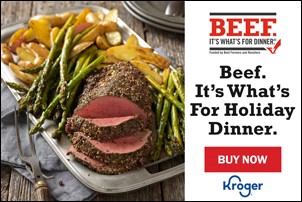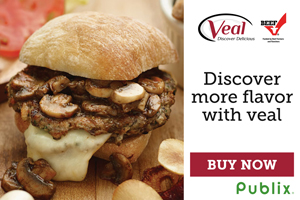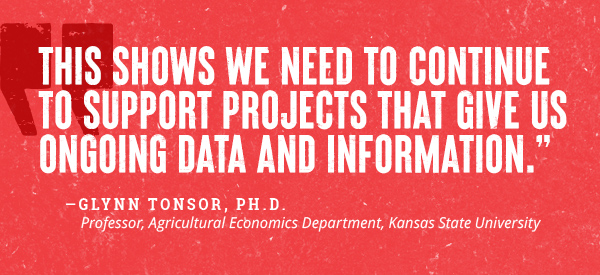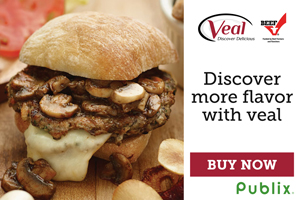Today, TikTok is a social media giant and a highly relevant social media platform, particularly for Gen Zs and millennials. With more downloads than even Facebook and Instagram, TikTok has more than 800 million monthly users worldwide. Because TikTok features so many key target audiences active in one space, the Beef Checkoff has joined in on the fun, promoting prepared beef and veal in unique and trendy ways.
The North American Meat Institute (NAMI) executes Checkoff-funded projects to promote prepared beef products. One goal is to get consumers to think about prepared products, like beef hot dogs, roast beef, corned beef and beef jerky in new and different ways – and TikTok is a platform where consumers embrace creativity. The food side of TikTok is one of the most popular and trending areas on the app. Here, users can find at-home, professional and celebrity chefs. To capitalize on food’s popularity on TikTok, NAMI ran three campaigns with the Food Renegades, the largest alliance of social media chefs in the world with 40 million followers combined.
The Checkoff-funded brand Veal – Discover Delicious has also been using TikTok to showcase veal’s versatility. Veal – Discover Delicious partnered with popular TikTok food creators to introduce veal to consumers and open their eyes to new recipe concepts.
These TikTok tournaments and highly engaging campaigns have brought out the originality in food creators. Prepared beef products were shown in shakshuka, Reuben casserole and even beef hot dog octopuses. Also, veal was highlighted in different burger and taco recipes.
The Beef Checkoff is excited to be working on new TikTok campaigns for the future and is consistently monitoring new technologies and platforms to continue reaching and engaging new audiences to drive demand for beef.
Online grocery and meal ordering grew tremendously throughout the 2020 pandemic, and this trend is only expected to continue growing in 2021 and beyond. Today, 67 percent of consumers are buying groceries online for delivery or pickup 1. In a retail space that is advancing at such a high speed, the Beef Checkoff implements e-commerce advertising campaigns with major retailers like Target, Sam’s Club, Kroger and Chicory to accelerate sales of fresh beef.
 These e-commerce campaigns feature Checkoff-funded Beef. It’s What’s For Dinner. digital advertisements that run on retailers’ websites and apps. During the 2020 holiday season, the Checkoff partnered with Chicory, a digital shopper marketing platform, to boost beef sales. Chicory is famous for its signature “Get Ingredients” button that can be found on more than 1,500 recipe websites. The Beef Checkoff used Chicory technology with top national retailers – Kroger and Target. The holiday-focused beef content for Kroger was served to an audience of 27 million hungry consumers, and for every Checkoff dollar invested $4.45 in beef was sold. Target’s beef content was served to an audience of 29 million, and for every Checkoff dollar invested, $5.19 in beef was sold. Several state beef councils also partnered with this effort to boost their own campaigns and extend reach and impact.
These e-commerce campaigns feature Checkoff-funded Beef. It’s What’s For Dinner. digital advertisements that run on retailers’ websites and apps. During the 2020 holiday season, the Checkoff partnered with Chicory, a digital shopper marketing platform, to boost beef sales. Chicory is famous for its signature “Get Ingredients” button that can be found on more than 1,500 recipe websites. The Beef Checkoff used Chicory technology with top national retailers – Kroger and Target. The holiday-focused beef content for Kroger was served to an audience of 27 million hungry consumers, and for every Checkoff dollar invested $4.45 in beef was sold. Target’s beef content was served to an audience of 29 million, and for every Checkoff dollar invested, $5.19 in beef was sold. Several state beef councils also partnered with this effort to boost their own campaigns and extend reach and impact.
After such a successful exploratory holiday e-commerce campaign, the Beef Checkoff ran a “kick-off to summer grilling” digital e-commerce campaign with Sam’s Club in April and May. This campaign featured Beef. It’s What’s For Dinner. summer-focused content across Sam’s Club digital platforms. When a consumer is shopping on the Sam’s Club’s website or app, they’ll see a Beef. It’s What’s For Dinner. banner, pop-up or other digital advertisements. The link in those advertisements takes consumers directly to Sam’s Club’s beef page, where it encourages members to buy high-quality beef online and try their Club Pickup format.
 The Checkoff-funded Veal – Discover Delicious brand also implements e-commerce campaigns with Chicory and notable retailers to increase veal sales. In February and March, a Chicory campaign gave consumers the opportunity to add veal directly to their virtual shopping carts with the click of a button. Veal saw great success with its content being delivered to more than one million people and 2,531 veal orders were added to baskets.
The Checkoff-funded Veal – Discover Delicious brand also implements e-commerce campaigns with Chicory and notable retailers to increase veal sales. In February and March, a Chicory campaign gave consumers the opportunity to add veal directly to their virtual shopping carts with the click of a button. Veal saw great success with its content being delivered to more than one million people and 2,531 veal orders were added to baskets.
The Beef Checkoff is already finalizing more digital marketing and e-commerce summer grilling campaigns with three additional national retail partners. Overall, online grocery ordering is here to stay, and the Beef Checkoff is committed to getting beef messaging in front of consumers, whether online or in-person.
When looking at a restaurant menu, you’ll most likely see various meal options ranging from beef, pork, chicken, vegetarian and so on. If you’re like most cattlemen and women, you’d like to see more beef dishes available at different restaurants everywhere. And who are the people making the executive decisions about what’s on those restaurant menus? Chefs.
Chefs, restaurateurs and other culinary professionals have the power to develop new beef recipes, include more beef items on their menus and deliver the high-quality beef their customers love. Chefs’ efforts in the kitchen contribute to beef demand, and that’s why they’re such a crucial target audience for the Beef Checkoff.
To get more beef on more menus, the Beef Checkoff has invested producer dollars into chef outreach tactics. Due to the coronavirus pandemic, chef outreach has pivoted to include technology-driven efforts and events. This is ideal in some circumstances because it allows the Beef Checkoff to reach larger audiences.
Virtual media tours have effectively reached both consumer and culinary audiences. These tours featured celebrity chefs in the Checkoff-funded Culinary Center located at the National Cattlemen’s Beef Association (NCBA) offices, a contractor to the Beef Checkoff.
The Culinary Center is an ideal location where chefs can develop and perfect their beef recipes. The virtual media tours hosted there offer reporters, newscasters and other media members from across the U.S. the ability to do one-on-one virtual interviews and news segments with celebrity chefs to learn more about them and why they love and choose beef.
In addition to the Culinary Center, NCBA has a Checkoff-funded restaurant engagement team dedicated to working with and appealing to professionals in the restaurant sector. This group of professionals executes the Beef News Now newsletter, which delivers the latest foodservice and retail news, trends and hot topics in the beef industry to food professionals. In light of the coronavirus pandemic, this team has encouraged and helped chefs adapt their menus to fit curbside and takeout trends.
Another Beef Checkoff effort to engage chefs was a video series that brought beef producers and chefs together to learn about beef’s lifecycle from pasture to plate. This unique video series was in partnership with Chef’s Roll, a global culinary community. It featured chefs on the ranch as they got a first-hand look at the care and best management practices producers put into producing high-quality beef. This series then shows the producers’ experiences as they tour the chefs’ restaurants to see how some of their most popular and complex beef dishes are made. The videos were shared with the Chef’s Roll culinary community through multiple social and digital channels, with their Instagram posts reaching nearly 800,000 culinary professionals. Through this video effort, thousands of chefs across the country are now enlightened on environmental stewardship, cattle handling techniques, quality control and animal welfare priorities.
Not only does the Beef Checkoff strive to reach chefs on a national level, but it also implements state-specific efforts through Qualified State Beef Councils (QSBCs).
Every QSBC implements its state-specific efforts and utilizes chefs through multiple initiatives. This can include recipe videos on YouTube and social media, live cooking classes, education-focused webinars on beef nutrition, cutting and serving techniques and promotional partnerships, to name a few.
One exciting state effort launched by the Texas Beef Council (TBC) is a new “Beef Loving Chefs” podcast. This gives chefs and others in the foodservice and hospitality industries the opportunity to share and listen to personal journeys, relationships and experiences with TBC and the Texas beef industry. One particular episode goes in-depth on one chef’s journey to modify his menu to capitalize on takeout demand and keep his restaurant afloat while in-person dining was prohibited.
On an international scale, the U.S. Meat Export Federation (USMEF), a contractor to the Beef Checkoff, also implements chef engagement tactics. USMEF executed numerous virtual cooking classes, training sessions, grilling workshops and demonstrations across the world this past year. At a particular training session, USMEF China showed chefs cutting and cooking best practices for Asian-style barbecue. U.S. beef cuts highlighted during this session were U.S. beef heart, hanging tender and top blade. More than 50 chefs and restaurant managers participated.
Whether it be a state, national or worldwide endeavor, the Beef Checkoff is dedicated to expanding chefs’ love of beef and getting more beef dishes on their menus.
How the Beef Checkoff supports technology and state-of-the-art research to disseminate meat demand data and grow industry knowledge.
To help drive consumer beef demand, the Beef Checkoff works to understand beef’s place in the protein marketplace. To successfully understand beef demand, the Beef Checkoff must first recognize consumer demand, views and preferences for all proteins, including meat alternatives.
For Glynn Tonsor, Ph.D., understanding consumer meat and food demand comes naturally. While growing up on a hog farm in Missouri, Dr. Tonsor quickly developed an interest in agricultural markets and pursued that interest, eventually taking on his current position as a professor in the Agricultural Economics department at Kansas State University.
 Today, Dr. Tonsor executes and authors the Meat Demand Monitor (MDM) project, funded in part by the Beef Checkoff and Pork Checkoff.
Today, Dr. Tonsor executes and authors the Meat Demand Monitor (MDM) project, funded in part by the Beef Checkoff and Pork Checkoff.
The MDM tracks U.S. consumer preferences, views and demand for meat with separate analysis for retail and foodservice channels. It is a monthly online survey with a sample of more than 2,000 respondents reflecting the national population. A third-party company continuously collects this consumer data every month. Overall, the MDM is a one-stop location for meat demand trends and assessments and is also available for all audiences.
Early on in his career, Dr. Tonsor noticed a knowledge gap on the demand side. According to him, one central theme continued to materialize through his research and discussions – producers don’t understand the importance of meat demand.
“Producers are used to watching the monthly cattle-on-feed report, reading annual cattle inventory reports and a whole wealth of supply-side monitoring, and that’s valuable,” he said. “On the demand front, there’s a lot less parallel information, and what does exist is pretty lax.”
Dr. Tonsor recognized the issue and information gap, talked to industry professionals, started a partnership with the U.S. Cattlemen’s Association (USCA), a contractor to the Beef Checkoff, and received approval and funding for the MDM project. In February of 2020, the MDM was officially up and running to increase knowledge about U.S. meat demand and help producers understand its importance.
Because the MDM was functioning before the coronavirus pandemic, the data gathered has proved valuable, specifically on foodservice versus retail insights.
“The main finding would be that, to date, retail beef demand has increased while foodservice peak demand has decreased,” Dr. Tonsor said. “This finding is important, not necessarily surprising, but we’re able to track it. And maybe at some point, we’ll see that being unwound. Hopefully, as 2021 concludes, we’ll start seeing the foodservice sector recover.”
The MDM has collected additional insights on the coronavirus’ impact on meat demand. These have been summarized in three separate COVID-19 special reports. The November report detailed how, even when consumers get vaccinated, about one-third of the people surveyed say they will not return to in-restaurant dining.
“Asking about a COVID vaccine isn’t in itself a meat demand question, but when you follow it up with a question like ‘How will you alter your dining out, sit-down and restaurant behaviors?,’ we’re able to understand what’s needed to help the recovery of the foodservice segment,” Dr. Tonsor said.
Analyzing these trends is critical for the Beef Checkoff to judiciously invest producers’ dollars in future projects to reach a new era of eating-at-home consumers.
Beef Checkoff marketing decisions take into account consumers’ protein values. These protein values—taste, freshness, safety, price, nutrition, health, appearance, convenience, hormone and antibiotic-free, animal welfare, traceability and environmental impact—are measured monthly and ranked by the respondent’s priority on the MDM.
Nearly all Checkoff-funded efforts and initiatives address at least one of these protein values, and more often than not, more than one. The MDM allows the Checkoff to continue measuring the relative importance of each protein value.
Every month the MDM results are consistent – taste, freshness and safety are a top priority for consumers.
“Every month, across 2,000 people, these protein values show more importance than things like animal welfare and environmental impact,” Dr. Tonsor said. “That doesn’t mean those values don’t matter, but they’re not the core decision driver for meat demand. They matter secondary, but not primary.”
These insights prove the Beef Checkoff should continue to invest in efforts and initiatives that sustain or enhance the taste, freshness and safety of beef.
As an industry, it’s hard to forecast the future. Often, industry stakeholders look back after the fact and wish there would have been more data available to make better decisions.
“I wish I had one or more years of pre-COVID meat demand monitor data. If I had that, I’d have richer insights on the COVID shocks,” Dr. Tonsor said. “I still consider this a success, and I hope others consider this a success, but this shows we need to continue to support projects that give us ongoing data and information.”
The Beef Checkoff is proud to partner with USCA and Kansas State University on this research project to grow knowledge on consumer meat demand.
MDM reports, survey instruments and raw data are available here: https://www.agmanager.info/livestock-meat/meat-demand/monthly-meat-demand-monitor-survey-data
When consumers think about veal, they likely think that fancy, Italian, white-tablecloth restaurants are the only places that serve veal nowadays. The Beef Checkoff is changing that narrative and promoting veal as a nutritious, delicious option for any consumer.
The Checkoff-funded National Veal Program, executed by the New York Beef Council and the North American Meat Institute (NAMI) developed a new brand and website to invite consumers to “Discover Delicious” in veal.
Veal – Discover Delicious, integrates the former vealmadeeasy.com and vealfarm.com platforms and was developed with veal stakeholders’ input. The website features upcoming events, blog articles and cooking school information. Veal producers and other industry stakeholders can use the site to see extensive consumer outreach efforts. This website also shows consumers where to buy veal online, in butcher shops or at grocery stores.
Along with this website launch, the brand has several other ongoing campaigns and events. Here’s a program snapshot:
 Family Features Campaign Highlights Veal’s Versatility – This social media and digital-focused campaign with Culinary.net uses veal as a popular and trending recipe ingredient for families. One new recipe was a buffalo baked veal cutlet sandwich. To date, this campaign has 725 total placements across the country in print media, online and social media networks, totaling 68,183,494 impressions.
Family Features Campaign Highlights Veal’s Versatility – This social media and digital-focused campaign with Culinary.net uses veal as a popular and trending recipe ingredient for families. One new recipe was a buffalo baked veal cutlet sandwich. To date, this campaign has 725 total placements across the country in print media, online and social media networks, totaling 68,183,494 impressions.
Veal Wins Big on Chicory Promotion – An important goal of veal’s outreach is to touch different and new consumers, making them aware of veal as a protein option and how it can fit into their weekly meal choices. One way this was accomplished was through a campaign with Chicory, a digital shopper marketing platform that turns recipes into a retail environment and reaches consumers through an online recipe network. Consumers had the opportunity to add veal directly to their virtual shopping carts with the click of a button. Beef Checkoff dollars invested in this campaign were doubled by contributions from other brand partners, such as Victoria’s Pasta Sauce. Brand partners were complementary to veal, allowing consumers to see veal in a cooked application. The overall campaign was then supported by the Florida and Wisconsin State Beef Councils. This campaign ran from mid-February to mid-March, and at the second performance report in early March, there were more than one million impressions and 2,531 veal orders were added to baskets.
 Consumers Gather for the ‘Love of Veal’ – Nine consumers joined both in-person and virtually from around the nation to take part in a veal cooking experience with Chef Patrick Rae and a wine tasting with Laurie Forster. The class taught consumers how to make two veal recipes with a romantic theme for Valentine’s Day. There was a 45 percent increase in comfort level among the participants in cooking veal following this class. Overall, participants gave the class 4.5 stars. More consumer cooking classes are planned for the rest of the year.
Consumers Gather for the ‘Love of Veal’ – Nine consumers joined both in-person and virtually from around the nation to take part in a veal cooking experience with Chef Patrick Rae and a wine tasting with Laurie Forster. The class taught consumers how to make two veal recipes with a romantic theme for Valentine’s Day. There was a 45 percent increase in comfort level among the participants in cooking veal following this class. Overall, participants gave the class 4.5 stars. More consumer cooking classes are planned for the rest of the year.
“SO enjoyed your For the Love of Veal virtual cooking class last night! I appreciate you taking the time to ‘de-mystify’ beef industry practices regarding veal, and I followed along with Chef Patrick’s instructions to make veal marsala, green beans and fingerling potatoes.” – Participant feedback.
National Collegiate Veal Cooking Competition – State Beef Councils in Wisconsin, Indiana, New York, Arizona and Florida connected with their culinary institutes and students to extend the opportunity to be a part of the State and National Collegiate Cooking Competition. Students take the time to learn about veal production and then create a recipe of their own design for a consumer audience. One winner from each state will receive a scholarship prize and compete at the national level for additional scholarship money. There has been a 125 percent increase in State Beef Council participation in this program since 2019.
Major metropolitan areas like New York City, Boston, Baltimore, Philadelphia and Washington D.C. in the Northeast are home to 72 million residents. With so many consumers in one region, the Beef Checkoff actively promotes beef in these cities along the I-95 corridor.
Checkoff-funded promotion to grow consumer trust in beef is executed through the Northeast Beef Promotion Initiative (NEBPI), a subcontractor to the Beef Checkoff. NEBPI extends nationally developed Beef Checkoff messaging in the country’s heavily populated Northeast region, where there are only three active State Beef Councils and only 3.8 percent of all Beef Checkoff dollars are collected.
This gap between limited Checkoff dollar resources and a growing population of consumers in the Northeast created a clear opportunity to channel nationally collected Checkoff dollars into this region. NEBPI began in 2004 when representatives from various State Beef Councils and industry organizations in the Northeast region discussed the opportunity to initiate a program specifically for that purpose. In the fall of 2005, an authorization request to fund and initiate the NEBPI program was presented and approved by the Beef Promotion Operating Committee. Sixteen years later, NEBPI has seven State Beef Council funding partners – Colorado, Iowa, Virginia, Kentucky, South Dakota, Montana and Delaware – helping to promote beef in the northeast.
This March, the North American Meat Institute (NAMI), a contractor to the Beef Checkoff, is executing exciting new efforts to celebrate National Deli Meat Month. Determined to “beef up” the month-long celebration, NAMI is turning National Deli Meat Month into an American favorite.
Growing National Deli Meat Month is key to expanding consumer demand for prepared beef – and research shows deli meat is extremely valuable to the beef industry.
 Nielsen data from 2019 shows that meat items sold beyond the fresh meat department have a value of $23 billion, with $13 billion coming from the deli department. Additionally, The 2019 Power of Meat Report states that in a given month, shoppers were buying meat across the store, including 37 percent in the deli, 39 percent fully cooked and 49 percent frozen.
Nielsen data from 2019 shows that meat items sold beyond the fresh meat department have a value of $23 billion, with $13 billion coming from the deli department. Additionally, The 2019 Power of Meat Report states that in a given month, shoppers were buying meat across the store, including 37 percent in the deli, 39 percent fully cooked and 49 percent frozen.
Ultimately, research has shown that consumers turn to deli meats, especially during unprecedented times. One remarkable data point tracked by 210 Analytics and IRI, a market research and data analysis company, in the first weeks of the global pandemic in March 2020 was that deli meat sales jumped as high as 40 percent over sales during the same week in March 2019.
To build upon consumers’ desire for deli meats, NAMI set a strong foundation for National Deli Meat Month in 2020. To do this, NAMI partnered with the National Pork Board (NPB) to create an entirely new campaign to promote and advance National Deli Meat Month. Together, an outreach campaign was directed to retailers, health professionals, dietitians, restaurateurs and consumers, encouraging them to enjoy their favorite deli meats and reminding them they can feel good about these popular cuts’ nutritional benefits.
This effort’s centerpiece was a newly created website –www.nationaldelimeatmonth.org – which provides a multitude of new resources including logos, messages, infographics, fact sheets, nutrition information and the latest news. Combined, these efforts reached consumers more than 600 million times and engaged more than 350,000 key opinion leaders. Partnering with the NPB helped generate momentum around National Deli Meat Month.
Throughout March, this momentum helped increase consumer demand for deli meats. The industry is now well-positioned to effectively grow National Deli Meat Month and adopt a long-term commitment to build upon each year.
Similar to past years, efforts to reach key audiences included press releases, television segments, eblasts, print ads and personal contact with top nutrition communicators. To upgrade things in 2021, NAMI and NPB developed more partnerships, created more activity opportunities and engaged with more retailers, health professionals, dietitians, restauranteurs and consumers than ever before. New assets, including an online toolkit complete with communication and activation ideas for retailers and producers, are available to inspire customer engagement and promotion at both the store and community levels.
A significant outreach effort to members, retailers and appropriate restaurants, like Subway and other sandwich chains, encouraged them to promote National Deli Meat Month – either using the existing materials or creating their own supporting activations. Additionally, NAMI has forged a new partnership with the International Dairy Deli Bakery Association (IDDBA) to extend this outreach and engagement to their membership, including more than 1,500 companies ranging from small independents to the world’s largest corporations.
To take advantage of fun, innovative virtual happenings, NAMI and NPB are executing Deli Dinner “Meat” & Greets. Building off of NAMI’s first Hot Dog Zoom Happy Hour success in 2020, Deli Dinner “Meat” & Greets will feature nutrition communicators and big brands as a way to encourage a break from the long-held image of deli meat as only lunch and sandwich options.
Also new this year is a National Deli Meat Month TikTok promotion. NAMI has seen great success through TikTok in the past year, and it plans to grow prepared beef’s presence on the platform. In partnership with The Food Renegades, a division of The Digital Renegades digital marketing agency and a chef alliance on TikTok, NAMI and NPB will be launching an exciting effort for National Deli Month that includes leading influencers sharing their enthusiasm for deli meats.
Overall, as National Deli Meat Month moves into its second year of promotion, NAMI is confident these efforts are only just the beginning, and consumers’ love of deli meat will continue to grow.